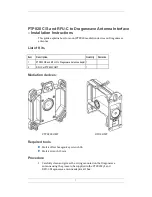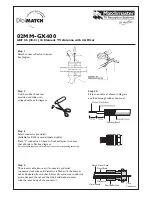
helps lower the base impedance. Second, a 4:1 toroidal transformer (voltage balun)
steps the base impedance down to 50 ohms. This transformer uses a ferrite core for
high power capability. Also, the windings are made of twisted pair wire to improve
coupling and reduce loss. A second high power transformer is configured as a 1:1
current balun to help stop RF from traveling back on the feedline shield. The radiator
of the AV-680 is at DC ground potential for static drain. This is accomplished by a
radio frequency choke in the matching circuit.
The center radiator of the AV-680 supports 1/4 wavelength stubs for 6 , 10, 12 and 17
meters. The stubs are placed approximately one tenth of a wavelength (electrically 1/8
wavelength) above the AV-680 base. At the top of each stub the impedance is very high
at the frequency the stub is tuned. This high impedance stops, (chokes) RF at this point
creating a resonant 3/8 wavelength radiator. There is minimal loss using this method as
compared to standard trap circuits. Also, VSWR bandwidth is not restricted by the °Q"
of trap components. For 20, 30, 40 and 80 meters, a coil and capacity hat are used on
each band to create a 3/8 wavelength radiator. The coils are mounted at the top of the
center radiator. These foer coils are connected in parallel. Parallel connection separates
each band to allow individual band tuning and has less loss than does series connection.
Also, the AV-680 coils have significantly less loss than a standard trap because the AV-
680 capacity hats exhibit greater capacitance than a typical trap, therefore, less
inductance is required.
Antenna Location
The best performance for receiving and transmitting will be obtained by mounting the
antenna in a clear location above or away from buildings, buildings, towers, feedlines,
utility wires, and other antennas. While your own ingenuity and particular circumstances
will determine the final mounting method, remember, any object within 75 feet from the
base of the antenna can influence the performance of the AV-680.
WARNING: Always mount this antenna so that it is out of the reach
of adults as well as children and pets. The counterpoise rods can
cause injury and or severe RF burns.
·
NEVER mount this antenna in a location that will permit
unsuspecting people to come in contact with any part of the
antenna.
·
NEVER mount this antenna where a mechanical failure might
allow the antenna, antenna support or feedline to contact power
lines or other utility wires.
·
ALWAYS ground the feedline at the point where it enters a
building to a good earth ground for lightning protection.
·
ALWAYS follow the guidelines for antenna installations as
recommended by the US Consumer Product Safety Commission.
3




































